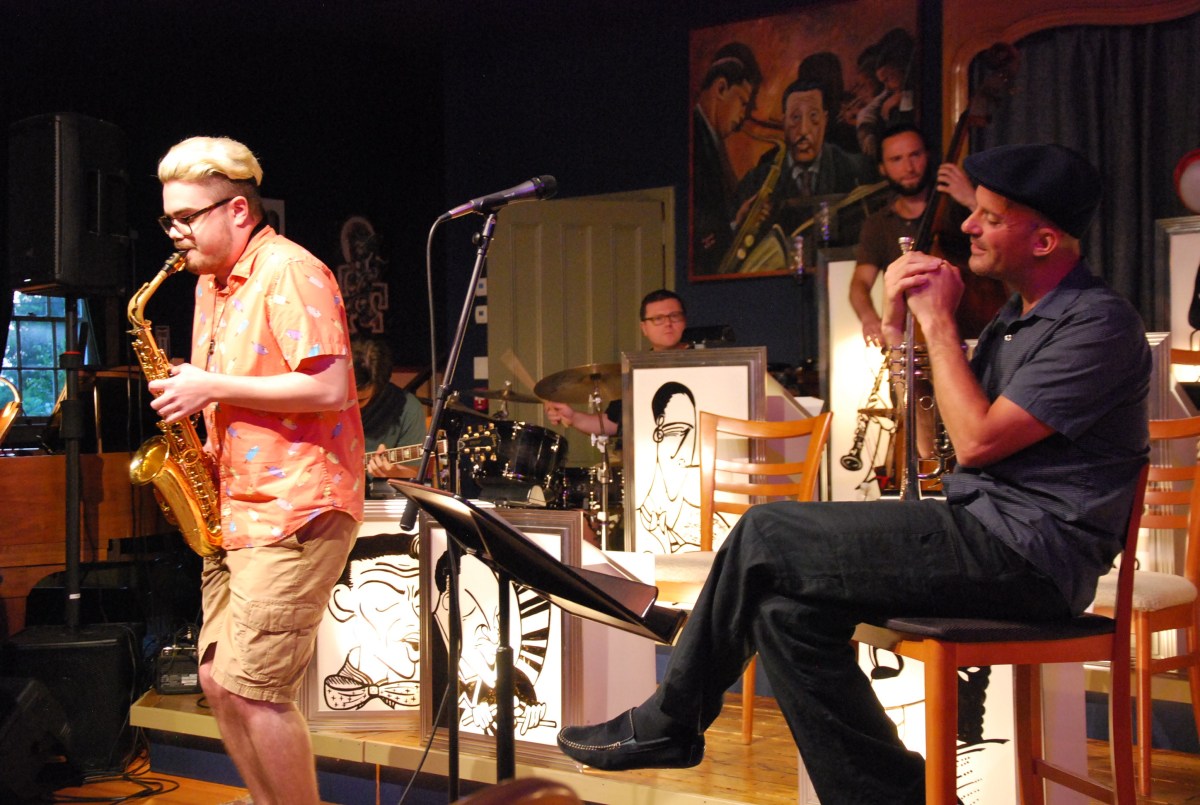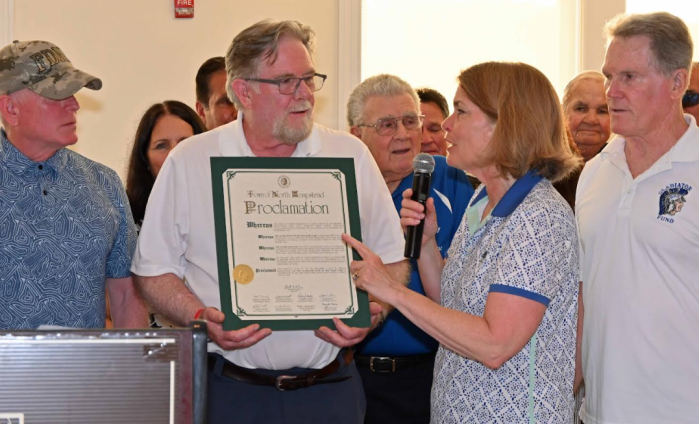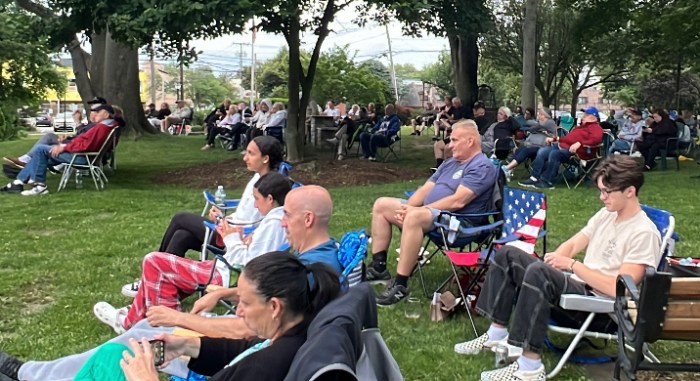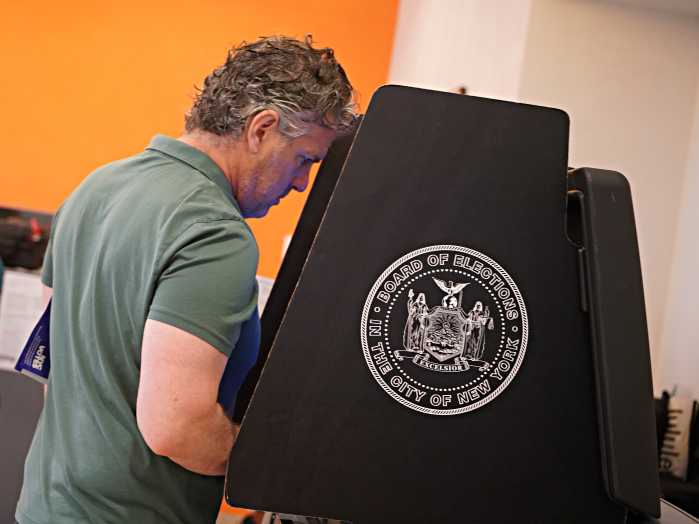Thomas Manuel sat perched on a stool, his silver trumpet cradled in his lap, a full smile on his face, as Thom Avella, a Long Islander now studying at Potsdam’s Crane School of Music, coaxed his alto sax through the Thelonious Monk standard “Evidence.”
It was open jam night on a recent Wednesday at The Jazz Loft, a crowded upstairs venue housed in a onetime tavern cum firehouse turned shuttered museum in Stony Brook village. The jam provides a night for area musicians and wannabes – many of them students, many in their teens – to hang out, catch some live acts, and get on stage to hone their skills, according to Manuel, who founded The Loft last spring.
“I’m humbled and proud of the jam night,” Manuel said. “It’s such a real, genuine event and it’s very special to me.”
Avella, the sax player, bounced on the balls of his feet as he played to a small crowd of students, parents, and fans, his bleach-blond pompadour moving with the music. After each musician took a turn – drums, standup bass, guitar, piano and eventually, Manuel – the tune finally came to an end. Bass player Keenan Zach, who generally runs the jam after performing with TJL’s house trio, grabbed hold of the microphone.
“Alright, folks,” he said. “Let’s get some new faces up here.”
A ‘utopian jazz place’
Manuel started the night downstairs, welcoming guests and selling tickets. There is a paid cleaning woman, but the staff is otherwise all-volunteer.
“So you end up wearing a lot of hats,” he said.
Manuel, a 37-year-old St. James resident, runs the pre-college music division of Stony Brook University’s jazz program and holds positions as a music educator at Long Island University and Suffolk Community College. He’s also an accumulator of jazz memorabilia, music, art and photography, a passion that had stopped just sort of hoarding.
“I had stuff everywhere. The basement, the attic, the shed. My house was basically a museum,” he admitted, adding that he was able to display some of the items when he played gigs or put on tribute concerts. “But it got to the point where the majority of it wasn’t even being used.”
Eventually, Gloria Rocchio, president of the Ward Melville Heritage Organization, caught wind of Manuel’s extensive collection and reached out.
“She said they had an old museum that needed a little work. And she asked if I might be interested in doing something with my collection,” Manuel explained. “That’s basically how it started.”
Asked to give a proposal to the organization, Manuel enlisted the help of friend and colleague Ray Anderson, a jazz trombonist and director of jazz studies at Stony Brook University. They started brainstorming.
“We had absolutely nothing to lose,” Manuel said. “So we dreamt up what would be the utopian jazz place.”
Knowing they had little backing or funding, they laid out the idea for The Jazz Loft as a non-profit organization with a three-pronged mission: to promote jazz education, preservation and performance.
“We were organized, but we had no idea about stuff like operating costs,” Manuel said. “They don’t teach you that in music school. But toilet paper costs a lot of money when you’re buying a lot of it.”
Rocchio’s group liked what they heard, and offered the space on terms even Manuel & Friends could afford: $1 a year.
With the help of sponsors, The Loft has managed to bring in top jazz acts, put on workshops for students, host those weekly jam sessions and collaborate with such local organizations as the art-focused Atelier at Flowerfield in St. James.
And then there is the collection of memorabilia and art work on display, much of it from Manuel’s 10,000+-piece personal stash.
(But not all: Jean Prysock, whose husband Arthur was a Top 10 jazz and R&B crooner during the 1950s-70s, donated her husband’s memorabilia after meeting Manuel in a Patchogue club. Louis Jordan, one of the most successful black artists of the last century – across all genres – is also represented, thanks to a gift from his widow, Martha.)
The display includes a collection of late 1800s banjos and violins, an early watercolor of Dizzy Gillespie, dozens of old brass instruments and entire walls lined with old photographs of the jazz world’s biggest names, including Armstrong, Ellington and Coltrane. There are record masters from Ella and Bing and Hoagy and the hand-written sheet music of “It Is Written in the Stars,” a little-known composition by “Take the A Train” composer Bill Strayhorn that Manuel acquired and commissioned orchestration for.
Even the three-tier bandstand has a history: It was constructed from remnants of the dance floor of NYC’s famed Roseland Ballroom on 52nd Street, demolished in 2015 to make way for a residential tower.
A changing scene
Most importantly, perhaps, the Loft is helping keep the music alive.
And it needs the help.
“As a musician, I’ve had the privilege to travel a bit,” Manuel said. “Jazz, which is an American-born art form, is sadly so much more appreciated in many, many other places than here in the U.S.”
That’s true, sadly, on Long Island, where jazz clubs in Huntington and Port Jeff have recently gone dark. Treme in Islip is still holding on, with performances Wednesday through Sunday most weeks. East Patchogue’s Denton Inn, where Lake Ronkonkoma native Manuel cut his teeth as a performer more than 20 years, still manages a Wednesday night jam. You can catch it on the right nights at Grasso’s in Cold Spring Harbor.
Still, Manuel says there are still plenty of opportunities for jazz musicians will to be proactive.
“I try to tell my students that they’re not just going to get hired when they get out of school,” he said. “They need to go out and find places to play. If there’s no venue, start a house concert series. Find a restaurant that serves incredible food and say, ‘the only thing that would make this place better is a little trio in the corner. How about we come in and play a free set so you can see what we’re about.’”
Manuel said he owes the success of The Jazz Loft to its volunteers and sponsors, although that’s clearly short-changing himself and the juggling act he does balancing his roles as teacher, father and husband and, now, impresario.
“It basically fits in any open minute. And it’s tough sometimes,” Manuel acknowledged. “But I can’t complain. I literally got to create my dream. I mean, how many people get to do that?”


































